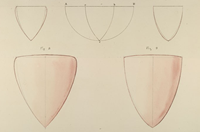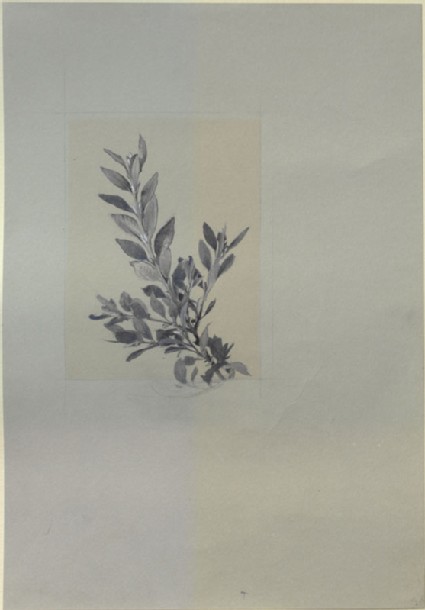Ruskin's Rudimentary series, 5th ed. (1873)
Items marked 'M' are drawings "by my own Hand" (by Ruskin), P are photographs, E engravings and A by Ruskin's Assistant, Arthur Burgess.

Ruskin's Catalogues: 1 object
Show search help- Reference URL
Actions
A growing Shoot of Box John Ruskin
-
Ruskin text
Process C. With pencil on white paper washed with neutral tint.Edu. 6. D. Study of box leaves. (This must be lent during the present term to the rudimentary school.)The use of the neutral tint (in this study, cobalt and Venetian red) is merely to fill up the white points inevitably left in any but the most finished pencil study; to take off the offensive metallic lustre, and to reinforce the gradations finally. A perfect study in any black material that did not shine would be better; but it would take a week to finish instead of a couple of hours: and the use of the neutral wash is, besides, a good preparation for future brush work.
Do all you can, first, with an HB pencil in moderate time, (I can do one of these leaf studies myself in a couple of hours; do not spend more than four or five in copying them), then put a thin wash of neutral tint over all except the highest lights: gradating it away to these. Let it dry perfectly, and then reinforce the shadows and define the lines, where necessary, with the same colour: but let the entire power of the drawing depend on the pencil, not the tint.
-
Details
- Artist/maker
-
John Ruskin (1819 - 1900)
- Object type
- drawing
- Material and technique
- bodycolour and ink over pen and ink and graphite on grey wove paper
- Dimensions
- 381 x 264 mm
- Inscription
- Verso:
towards bottom right, in graphite: E.268
centre, the Ruskin School's stamp
- Provenance
-
Presented by John Ruskin to the Ruskin Drawing School (University of Oxford), 1875; transferred from the Ruskin Drawing School to the Ashmolean Museum, c.1949.
- No. of items
- 1
- Accession no.
- WA.RS.ED.268
-
Subject terms allocated by curators:
Subjects
-
References in which this object is cited include:
References
Taylor, Gerald, ‘John Ruskin: A Catalogue of Drawings by John Ruskin in the Ashmolean Museum, Oxford’, 7 fascicles, 1998, Oxford, Ashmolean Museum, no. 235
Ruskin, John, The Ruskin Art Collection at Oxford: Catalogue of the Rudimentary Series, in the Arrangement of 1873, ed. Robert Hewison (London: Lion and Unicorn Press, 1984), p. 208
Ruskin, John, Catalogue of the Educational Series (London: Smith, Elder, 1871), cat. Educational no. XI.6.D
Ruskin, John, Catalogue of the Educational Series (London: Spottiswoode, 1874), cat. Educational no. 268
Ruskin, John, Catalogue of Examples Arranged for Elementary Study in the University Galleries (Oxford: Clarendon Press, 1870), cat. Educational no. 32.C
Ruskin, John, ‘The Ruskin Art Collection at Oxford: Catalogues, Notes and Instructions’, Edward T. Cook and Alexander Wedderburn, eds, The Works of John Ruskin: Library Edition, 39 (London: George Allen, 1903-1912), 21, cat. Educational no. 268
Location
-
- Western Art Print Room
Position in Ruskin’s Collection
Ruskin's Catalogues
-
Ruskin's Catalogue of Examples (1870)
32 C. Study of young shoot of box. (R.) Pencil, washed with cobalt and light red; outline here and there determined with the pen; buds touched with white—very badly, but, if I had begun to work upon them, the whole must have been more completed.I have sketched this rapidly to show you, in 32 B and C, the two uses of grey paper, for form seen in light against dark, and in dark against light, with power of final white in each.
-
Ruskin's Rudimentary series 4th ed. (1872)
Process C. With pencil on white paper washed with neutral tint.Edu. 6. D. Study of box leaves. (This must be lent during the present term to the rudimentary school.)The use of the neutral tint (in this study, cobalt and Venetian red) is merely to fill up the white points inevitably left in any but the most finished pencil study; to take off the offensive metallic lustre, and to reinforce the gradations finally. A perfect study in any black material that did not shine would be better; but it would take a week to finish instead of a couple of hours: and the use of the neutral wash is, besides, a good preparation for future brush work.
Do all you can, first, with an HB pencil in moderate time, (I can do one of these leaf studies myself in a couple of hours; do not spend more than four or five in copying them), then put a thin wash of neutral tint over all except the highest lights: gradating it away to these. Let it dry perfectly, and then reinforce the shadows and define the lines, where necessary, with the same colour: but let the entire power of the drawing depend on the pencil, not the tint.
-
Ruskin's Rudimentary series, 5th ed. (1873)
Process C. With pencil on white paper washed with neutral tint.Edu. 6. D. Study of box leaves. (This must be lent during the present term to the rudimentary school.)The use of the neutral tint (in this study, cobalt and Venetian red) is merely to fill up the white points inevitably left in any but the most finished pencil study; to take off the offensive metallic lustre, and to reinforce the gradations finally. A perfect study in any black material that did not shine would be better; but it would take a week to finish instead of a couple of hours: and the use of the neutral wash is, besides, a good preparation for future brush work.
Do all you can, first, with an HB pencil in moderate time, (I can do one of these leaf studies myself in a couple of hours; do not spend more than four or five in copying them), then put a thin wash of neutral tint over all except the highest lights: gradating it away to these. Let it dry perfectly, and then reinforce the shadows and define the lines, where necessary, with the same colour: but let the entire power of the drawing depend on the pencil, not the tint.





